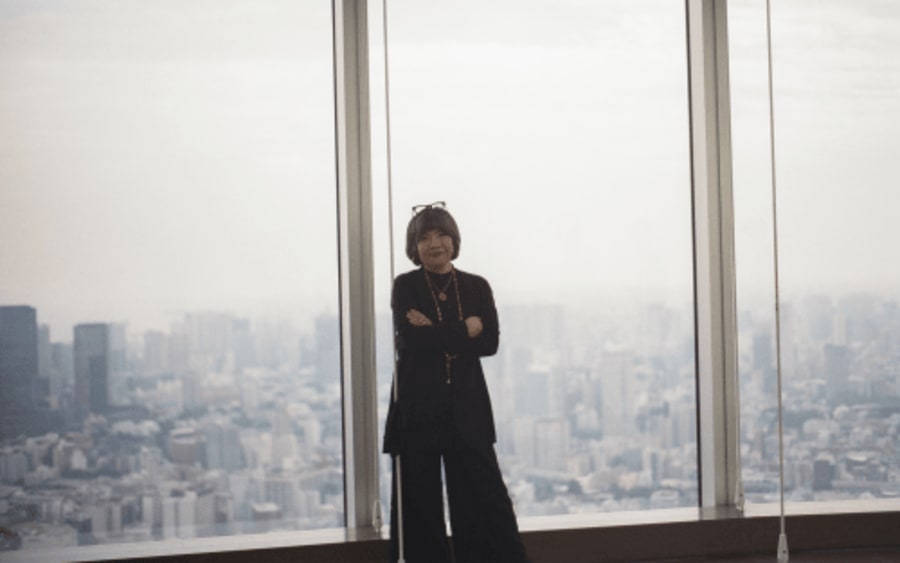駐紐約藝術家Jeremy Couillard原本是一名高中西班牙文教師,但在課堂之外,他投入大量時間創作複雜精細的漫畫和墨水畫。後來,他進入哥倫比亞大學攻讀藝術碩士,專心學習繪畫。但他很快感到厭倦:「我發現自己花在螢幕前的時間比在現實中的時間還多,因此科技話題越來越吸引我。甚至在畫畫時,我也大多是盯著電腦螢幕。」
因此,Couillard自學了程式設計,並開始嘗試動畫和3D遊戲創作工具虛幻引擎(Unreal Engine)。如今,他以創作敘事荒誕且帶有超現實主義風格的遊戲而聞名,比如《Escape from Lavender Island》(2023)。這款遊戲也在他目前於麻省理工學院李斯特視覺藝術中心(MIT List Visual Arts Center)舉辦的個展中佔據核心位置。觀眾可以坐在豆袋沙發上,化身遊戲主角Zede Aksis。這個綠色的雙足生物在監獄牢房中醒來,發現自己的反烏托邦城市夢境變成了現實。玩家的任務是逃離這個霓虹閃爍的恐怖都市。在逃亡中,他們追隨愛慕的物件,為舞蹈駐足,甚至可以戴上向路人噴射藥物的面具。Couillard談到這款帶有達達主義色彩的遊戲時說:「它關乎在城市中作為人類的生存體驗。遊戲很荒謬,但也的確非常悲涼。我想通過這款遊戲捕捉生存在當今社會的狀態。」
此次展覽還展示了一部隱隱透著詭秘氣息的視頻裝置,鏡頭掃過「Lavender Island」(薰衣草島)上奇異社區,伴隨著城市居民的旁白。不遠處,數碼繪製的木質花朵沿著地面綻放,牆上是幾幅色彩斑斕的畫作,猶如從遊戲中直接擷取的畫面。牆上還掛著一件滑稽的超大號螢光黃衛衣,上面印著「Depression」(抑鬱)。
展覽詼諧地批判了科技在社會中造成的疏離與隔閡。Couillard表示:「這種現象令人沮喪,但也讓人啼笑皆非,因為我們正在構建一個幾乎無人嚮往的科技世界,卻仍然義無反顧地向前推進。這個遊戲叫做《Escape from Lavender Island》(逃離薰衣草島),但在某種意義上,我們無法逃離現代生活。無論是福是禍,我們註定相伴。但我相信這終究是件好事,只要我們學會和彼此相處。」
These buyers have been venturing back into buying art from abroad despite the yen falling to its weakest level against the US dollar since the 1980s. Japanese collectors are beginning to see more value in acquiring art from overseas, according to Kayoko Yuki, founder of KAYOKOYUKI, a gallery located in Toshima ward of Tokyo. ‘For many young collectors, the numbers [monetary value] are significantly tied to their evaluation of art,’ she says.
Japan has no shortage of cultural experiences, and the country’s commercial offerings have been bolstered by the Art Collaboration Kyoto fair, which pairs Japanese galleries with overseas dealers in shared booths, and Art Week Tokyo (both established in 2021). Held back-to-back this year, visitors hopped on the Shinkansen from Kyoto to Tokyo.
The latest edition of the Tokyo event, which ran from 7 to 10 November, involved a reported 4,000 foreign and domestic VIPs who signed up for visits to commercial galleries, museums, and artist studios across the metropolis. At the Artizon Museum in the Chūō ward, installations and sculptures by Yuko Mohri – who represented Japan at this year’s Venice Biennale – were on show in dialogue with works from the Ishibashi Foundation Collection. Meanwhile, Louise Bourgeois had a retrospective at the Mori Art Museum and Keiichi Tanaami had one at the National Art Center, Tokyo.
AWT Focus, the curated sales platform of Art Week Tokyo, was mounted at the Okura Museum of Art, Japan’s first private museum. Curated by Mori Art Museum director Mami Kataoka, the show included works by Lynda Benglis, Yutaka Hatta, Nelo Akamatsu, Sopheap Pich, Mit Jai Inn, Taloi Havini, Ken and Julia Yonetani, and other major artists from Japan and abroad. ‘The fact that the city itself offers so much to see and do is a double-edged sword. The audience’s attention can be drawn away with all the other things that are happening in the city,’ says Charles Fong, the director of the Hong Kong- and London-based gallery Rossi & Rossi, which shared a booth with Tokyo’s Satoko Oe Contemporary.
However, dealers are banking on more consistent audiences, with high-net-worth individuals trickling into Japan for more permanent stays. Blum observes that Tokyo is ‘the place where most Asian collectors or people of means are setting up a second home – that’s increasing dramatically.’ He adds that the new generation’s commitment to collecting ‘has grown steadily.’
Four decades ago, when Japan’s economy was the second largest in the world (it’s now the fourth, behind the US, China, and Germany) and the Japanese art market was booming, corporations and conglomerates behind Japan Inc. were major art world buyers, acquiring works at record prices. One example is a Sunflowers painting by Vincent van Gogh that was sold to Yasuda Fire and Marine Insurance (now Sompo Holdings) at a Christie’s auction in 1987 for USD 39.9 million – an astonishing sum at the time.
Much has changed since then.
Shareholders are now holding Japanese corporations more accountable, in turn sparking questions around Japan Inc.’s disclosures about the value of its massive trove of fine art, a matter particularly critical for loss-making firms. This coincides with the Nikkei index surpassing levels unseen since the late 1980s, further reminding shareholders and regulators about these corporations’ once-acquisitive nature.
Now that many corporations are holding back from adding art to their existing collections, some gallerists believe high-net-worth individuals may partially fill that void – but only if there are reforms to Japan’s tax regimen.
Japan is a high tax country. The Survey of Global Collecting indicates that, for a significant portion of wealthy Japanese individuals, tax inheritance is a major factor in selling works. In fact, 72% of Japan-based respondents to the survey say estate taxes are a motivation to sell, suggesting art collections aren’t necessarily viewed as a legacy that can be reshaped and reinterpreted by each successive generation.
‘Most of the buyers we work with are first generation wealth. Within Japan, very rarely have I come across inherited wealth that ends up becoming collecting wealth. Most of the people that I deal with are self-made, successful businesspeople,’ Blum says.
Collecting attitudes may shift if there are adjustments to Japan’s onerous tax structure, however. As Ishii puts it: ‘If there are no changes to this tax system, people will hesitate to build a collection. It is essential to implement incentives, such as allowing at least 50% of an artwork’s market value to be deductible from the donor’s income when it is donated to a museum or similar institution.’
He adds: ‘The tax-deductible amount is currently capped at 1 million yen, which has benefited emerging artists. If this limit is raised to 5 million yen, it would likely further stimulate the market.’
Those changes seem like long shots in the immediate future, but gallerists see other bright spots. Ishii expects there to be a reassessment of outstanding Japanese artists whose presence is currently lighter in the market. ‘As it is still primarily a domestic market, there are high-quality works available at lower prices,’ he says.
With a growing wealth of events and opportunities, Japan may soon produce its next wave of active collectors who match the ambitions of Maezawa and those he inspired to become art buyers.
展覽「List Projects 30: Jeremy Couillard」由即日起至2024年10月6日於麻省理工學院李斯特視覺藝術中心展出。
本文作者Payal Uttam是一位常年於香港和新加坡兩地工作的獨立作家和編輯。她為不同出版物撰稿,包括Artsy、《藝術新聞》、《南華早報》及《華爾街日報》。
頁頂圖片標題:Jeremy Couillard,《Zede’s Dream》(靜幀),2023,圖片由藝術家提供
2024年9月2日發佈


